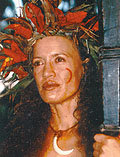Fijian family’s tale told through ‘Eyes’ of a camera
12 Aug 2014, Posted by in ARTICLES & INTERVIEWS| Fijian family’s tale told through ‘Eyes’ of a camera by Wayne Harada HonoluluAdvertiser.com, March 11, 2005 |
| Before making his first feature film, Vilsoni “Vili” Hereniko met a movie-maker from India who gave him the best advice possible:Look to your past, retrace your life, then share that story.”I was told to do a story that was close to my heart,” said Hereniko, whose first feature film, “The Land Has Eyes (Pear ta ma ‘on maf),” makes its first commercial run starting today at the Dole Cannery Theatres.”The advice was that my first feature should be set on an island I know, which is Rotuma, my birthplace, because ‘that’s the story only you could tell, better than anyone else,’ ” said Hereniko. ” ‘Go back to your childhood first.’ Of course, I didn’t want to go back; there was the issue of the death of my father, and the shame that happened to my family.”
That was the premise of “Land,” shot with a budget of just under $1 million, the first feature from a Fijian from Rotuma. Hereniko directed and wrote the screenplay; his wife, Jeannette Paulson Hereniko, co-produced, via their Te Maka Productions company. Not surprisingly, the story is near and dear to him. It incorporates a father accused of a crime he didn’t commit. But the protagonist now is a girl. Flash to Rotuma for a moment, and imagine a South Pacific island with little electricity, no hotel or restaurant, and a population of 2,500 that speaks a distinctive Polynesian language. Imagine Hereniko’s film crew of 14, spending 40 days to make the movie entirely on this island. Ninety-eight percent of the cast were Rotumans with no acting experience, and the filmmakers were assigned to families who agreed to house, feed and welcome the visitors. In “Land,” Hereniko retains a solid story-sharing skill with eye-filling clarity. He weaves in a number of themes, ranging from the love of the ‘aina to the desire to move on, from family pride to societal shame, from traditional values to changing times, from dashed hopes to lofty dreams. “Land,” which had its world premiere at the 2004 Sundance Film Festival, is a narrative drama set in the late 1960s. The tale focuses on Viki (newcomer Sapeta Taito), who prides herself on maintaining the integrity of her family’s name after her father, Hapati, is accused of stealing. The villagers taunt her for being poor, but Viki is determined to counter the teasings and rebound through the inspiration of the mythic Warrior Woman (played by Rena Owen, of “Once Were Warriors” fame). Hereniko said the Warrior Woman is the founding myth of Rotuma. “She has seven brothers, and one took advantage of her, then abandoned her. According to legend, that’s supposedly how the first woman got on the island. It’s interesting that it was a woman, not a man, to first inhabit the island. And according to the oral tradition, the brothers traveled on a canoe from Samoa and left her on the island before moving on to Fiji. That’s how Rotuma today has historical and cultural connections with Fiji.” The movie draws heavily from his life. “The protagonist originally was a boy; I mined all the actual events of my life, and Jeannette (his wife), said, ‘Why don’t you change the boy to a girl? Maybe that will free you up,’ ” said Hereniko. “I resisted, but once I agreed, it allowed me to use more imagination. It was a greater story — and it still had integrity.” Hereniko, who has written plays, academic books and articles, discovered how accessible the movie was to the story-loving Rotumans when he brought his finished product back to Rotuma to share. “It was amazing; the people came out of the woodwork, even the old folks; the laymen who no longer go to church found their legs. They all wanted to see the film,” he said. “We hauled white sheets from the hospital, rented a projector from the University of South Pacific, and brought the movies to all seven districts on the island and even to the school where the protagonist attended. Some programs were outdoors; we even had a screening on the veranda of the hospital, in spite of the message in the film when the father is ill and the line is, ‘Don’t take him to the hospital; he’ll die there.’ ”  Rena Owen plays the mythological Warrior Woman in the movie The lush cinematography, particularly the water sequences, are first rate, the work of Paul Atkins, the Oscar-winning cinematographer for the Cape Horn sequence in the Russell Crowe sea saga, “Master and Commander: The Far Side of the World.” “Paul has been a friend of Jeannette for years — he and his wife, Gracie, live nearby at Portlock — and Paul was very interested in doing a feature, having done so many documentaries. So it was a pair of two husbands and wives — Jeannette and me and Paul and Gracie — who worked on the film. It has been a nice friendship, personally and professionally,” said Hereniko.Gracie was the sound recorder, Jeannette the producer. The filming logistics were daunting. The crews had to bring generators, refrigerator and food for the 40-day shoot. Rotuma is not exactly the hub of air or sea traffic; to get supplies and equipment over, the movie-makers hired a cargo boat, which took three days and three nights to get the necessities and filming gear to the island. A plane was too small. Rotuma is 300 miles north of Fiji, about 80 square miles in size. “Changes are happening so fast,” said Hereniko. “Small planes fly to the island once a week, a boat goes once every two to three months, and it’s still a remote existence,” he said. “Many people now have phones; many thatched homes have been replaced.” Hereniko said “Land” emerged after the release of two other popular Polynesian films, “Once Were Warriors” and “Whale Rider,” though filming of his film was done before “Whale.” “It’s a good thing our film came out after these; many who came to ours enjoyed the earlier films,” he said. |
| The Honolulu Advertiser |

Sorry, the comment form is closed at this time.